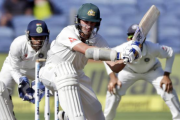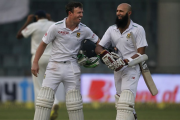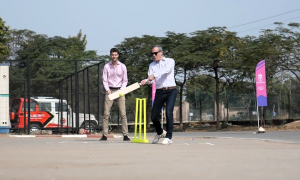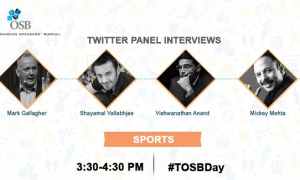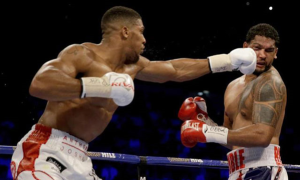The series equation now reads 2-2 however it has very less to convey about which the dominant team out of the two was. India has played with a usual half-strength squad with most of its first-choice players missing out due to injury woes. South Africa on the other hand, have always dominated the first 70-75 overs but have failed to capitalize on it in the rest of the overs especially in the second and third game. In the second game, the Proteas were well under control until Smith was there in the middle. 120 for 3 is a good enough score when you chase a target of 189 unless you do something insane to drift away from the game. India did bowl well, but the South Africans presented it in an exaggerated view. In Cape Town, India were down and buried at 93 for 5 but only before a blitzkrieg from Yusuf, a responsible innings from Raina and a cameo from Harbhajan saw India home. The fourth game at Port Elizabeth was entirely South Africa’s as they crushed India by 48 runs.
On analyzing the third game, I just can’t help getting the feeling that if Steyn and Morkel were brought back into the attack at 93 for 5 (when Yusuf and Raina were trying to get their eye in), South Africa would have wrapped up things very quickly given the way the bowled in the series opener game at Durban. The very first game of the series showcased India’s vulnerability against the short pitched stuff. Steyn and Morkel became nightmares for the youngsters to deal. The last game also indicated how Morkel can trouble an unsettled Pathan. Not just the game at Durban or the one at Port Elizabeth, it all started when Jerome Taylor and Fidel Edwards asked probing questions in the Super Eight game of T20 World Cup 2009. The tragic part of that game was West Indies just managed to win against India in that Super Eight, but they had their job done. “India no more has players who can comfortably if not adroitly cope with the bouncers” read the next day’s headlines. Every team that plays against India is now aware of its limitations. The game is started in the minds even before they take up their field.
After a similar kind of an exit in 2010, the Indian Captain cited the IPL’s hectic schedule on and off the field as a reason for India’s loss in the T20 world cup. He also emphasized that the absence of a 150 kmph-case-bowlers in India is costing them. Come with me to the ages when Sachin Tendulkar and Rahul Dravid, both in entirely different epochs, cut their teeth in International cricket. You will realize that India never had a history of having with them, the 150-case-bowlers. Yet the above dealt, and are dealing with them effortlessly. In fact when Sachin first took up the field, the dreadful pace bowling attack lead by Wasim Akram was ready to thump the 16-year-old kid down. While Dravid’s best has come in overcast conditions and those that assist seam movement and bounce, batting at No.3.
How were they able to deal with it? The answer was no secret, they were completely aware that the bowlers are going to bounce at them and were ‘mentally prepared’ for it. This is where the word that makes people to give a 100 percent in everything they do; the word that totals to 100 while adding the corresponding number of its letters comes to picture, the ‘ATTITUDE’. The men mentioned above and others who expertly dealt with the bouncers spent ages in the nets facing the short-pitched stuff, learning to pull, hook, play the upper-cut and duck against the odd one.
If you analyze a bit you will realize that the youngsters now have better opportunities for them to avail. Their IPL teams have at least one bowler who can bowl at the speed which Dhoni claimed Indian bowlers cannot bowl. So why can’t Rohit Sharma take up net sessions against Ryan Harris? Why can’t Raina take up sessions against Doug Bollinger? Again the answers for all these are in the minds. They get tempted to draw satisfaction from the IPL in conditions that doesn’t support bowling, let alone the conditions aiding bounce and movement for fast bowlers.
That is why Test cricket is considered as the best scale to judge a player. In test cricket you don’t escape from playing the bouncing balls because the result of the game doesn’t turn upside down in matter of overs. And that is why VVS Laxman’s 281 in Kolkata and Rahul Dravid’s 233 in Adelaide are commemorated as opposed to Yusuf Pathan’s match winning 56 against Chennai Super Kings in the final of the first edition of the IPL and Robin Uthappa’s quick 52 against Kolkata Knight Riders in the third edition, when citing examples about greatest knocks in cricket history.
India pins its hopes on the sub-continental conditions for the upcoming World Cup. Nevertheless, the Indians are better players of spin. In the subcontinent there is a fair bit of assistance for spin and little assistance for pace and bounce. The tracks are going to be undoubtedly flat, which means India start as clear favorites.
The biggest test for India will lie on how they play the rest of the season where they have to tour West Indies and England, the latter seems to eagerly await its turn to face India in its hometown.
There are two contrasting occurrences in the history of Indian cricket. In 1994, when Courtney Walsh bounced, Vinodh Kambli (was just 22 then), didn’t know how to deal with it and never played a test match. In the World Cup 2003 when England questioned India’s capabilities against the bouncers on the eve of their game against India, Sachin hooked one outside the stadium and Dravid pulled one; both yielding the same result- ‘SIX’. There are no secrets behind their game: when a challenge was posed against them, they were mentally prepared for it or they had the ‘attitude’ to take it the right way.
The situation now is no different, the youngsters now know Dale Steyn, Morkel, Anderson, Tremlet, and Jerome Taylor etc are going to bounce at them. The question now is ‘Are they up to the challenge?’
When Shiv Khera deals about the modern obsession to look for shortcuts in his ‘You Can Win’, he narrates a story which concludes as: if there was one piece of wisdom that can be passed on to future generations, it is this one sentence: “There is no free lunch.”
Class and Genius thrive in adverse conditions; the conditions where the weak doesn’t dare to enter and mediocre quits halfway. And the Class and Genius are the results of perspiration and extraordinary work-ethic!
Tags: 4th ODI, Cricket, D/L Method, India, JP Duminy, ODI Cricket, ODI Series, Port Elizabeth, South Africa, Virat Kohli





